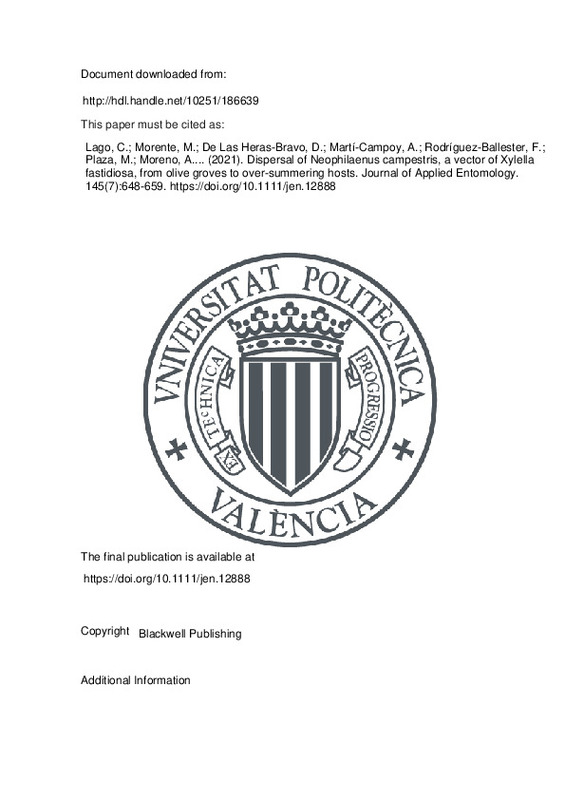JavaScript is disabled for your browser. Some features of this site may not work without it.
Buscar en RiuNet
Listar
Mi cuenta
Estadísticas
Ayuda RiuNet
Admin. UPV
Dispersal of Neophilaenus campestris, a vector of Xylella fastidiosa, from olive groves to over-summering hosts
Mostrar el registro sencillo del ítem
Ficheros en el ítem
| dc.contributor.author | Lago, Clara
|
es_ES |
| dc.contributor.author | Morente, Marina
|
es_ES |
| dc.contributor.author | De las Heras-Bravo, Daniel
|
es_ES |
| dc.contributor.author | Martí-Campoy, Antonio
|
es_ES |
| dc.contributor.author | Rodríguez-Ballester, Francisco
|
es_ES |
| dc.contributor.author | Plaza, María
|
es_ES |
| dc.contributor.author | Moreno, Aránzazu
|
es_ES |
| dc.contributor.author | Fereres, Alberto
|
es_ES |
| dc.date.accessioned | 2022-09-27T18:04:14Z | |
| dc.date.available | 2022-09-27T18:04:14Z | |
| dc.date.issued | 2021-08 | es_ES |
| dc.identifier.issn | 1439-0418 | es_ES |
| dc.identifier.uri | http://hdl.handle.net/10251/186639 | |
| dc.description.abstract | [EN] Neophilaenus campestris is one of the spittlebugs (Hemiptera: Cercopoidea) able to transmit Xylella fastidiosa to olive trees. Considering its vector ability and the wide distribution of this species in Spain, N. campestris should be considered a serious threat to key crops such as olive, almonds and grapevines. Migration and dispersal abilities of insect vectors have profound implications in the spread of vector-borne diseases. Thus, knowledge on the dispersal ability of N. campestris is essential to model, predict and limit the spread of the diseases caused by X. fastidiosa. A mass-mark-recapture technique was developed to track between-field movements of N. campestris during its late spring migration from the ground cover grasses within olive groves to sheltered areas dominated by pine trees. The fluorescent dust used for marking did not affect the survival nor the flying ability of N. campestris. Spittlebug adults captured in olive groves during late spring were dusted with fluorescent colours and released in different locations. Six recapture samplings were performed 23¿42 days after release in 12 different sites located within a maximum distance of 2.8 km from the release point. Results indicated that N. campestris was able to disperse a maximum distance of 2,47 m in 35 days. Furthermore, flight mill studies showed that N. campestris was able to fly long distances, reaching 1.4 km in an 82-min single flight. Altogether, our findings suggest that eradication measures are of limited value because vectors are able to disperse rapidly over distances much longer than expected. | es_ES |
| dc.description.sponsorship | Ministerio de Ciencia e Innovacion, Grant/Award Number: AGL2017-89604--R and PRE2018-083307; Comunidad de Madrid, Grant/Award Number: FP19-XYLELLA | es_ES |
| dc.language | Inglés | es_ES |
| dc.publisher | Blackwell Publishing | es_ES |
| dc.relation.ispartof | Journal of Applied Entomology | es_ES |
| dc.rights | Reserva de todos los derechos | es_ES |
| dc.subject | Fluorescent dust | es_ES |
| dc.subject | Insect vector | es_ES |
| dc.subject | Mass-mark-recapture (MMR) | es_ES |
| dc.subject | Migration | es_ES |
| dc.subject | Pinus halepensis, Pinus pinea | es_ES |
| dc.subject.classification | ARQUITECTURA Y TECNOLOGIA DE COMPUTADORES | es_ES |
| dc.title | Dispersal of Neophilaenus campestris, a vector of Xylella fastidiosa, from olive groves to over-summering hosts | es_ES |
| dc.type | Artículo | es_ES |
| dc.identifier.doi | 10.1111/jen.12888 | es_ES |
| dc.relation.projectID | info:eu-repo/grantAgreement/AEI/Plan Estatal de Investigación Científica y Técnica y de Innovación 2013-2016/AGL2017-89604-R/ES/ECOLOGIA, COMPORTAMIENTO Y CONTROL DE PHILAENUS SPUMARIUS, EL VECTOR DE XYLELLA FASTIDIOSA:UNA NUEVA AMENAZA PARA LA AGRICULTURA ESPAÑOLA/ | es_ES |
| dc.relation.projectID | info:eu-repo/grantAgreement/MICINN//PRE2018-083307/ | es_ES |
| dc.relation.projectID | info:eu-repo/grantAgreement/CAM//FP19-XYLELLA/ | es_ES |
| dc.rights.accessRights | Abierto | es_ES |
| dc.contributor.affiliation | Universitat Politècnica de València. Departamento de Informática de Sistemas y Computadores - Departament d'Informàtica de Sistemes i Computadors | es_ES |
| dc.description.bibliographicCitation | Lago, C.; Morente, M.; De Las Heras-Bravo, D.; Martí-Campoy, A.; Rodríguez-Ballester, F.; Plaza, M.; Moreno, A.... (2021). Dispersal of Neophilaenus campestris, a vector of Xylella fastidiosa, from olive groves to over-summering hosts. Journal of Applied Entomology. 145(7):648-659. https://doi.org/10.1111/jen.12888 | es_ES |
| dc.description.accrualMethod | S | es_ES |
| dc.relation.publisherversion | https://doi.org/10.1111/jen.12888 | es_ES |
| dc.description.upvformatpinicio | 648 | es_ES |
| dc.description.upvformatpfin | 659 | es_ES |
| dc.type.version | info:eu-repo/semantics/publishedVersion | es_ES |
| dc.description.volume | 145 | es_ES |
| dc.description.issue | 7 | es_ES |
| dc.relation.pasarela | S\438190 | es_ES |
| dc.contributor.funder | Comunidad de Madrid | es_ES |
| dc.contributor.funder | Agencia Estatal de Investigación | es_ES |
| dc.contributor.funder | Ministerio de Ciencia e Innovación | es_ES |







![[Cerrado]](/themes/UPV/images/candado.png)

